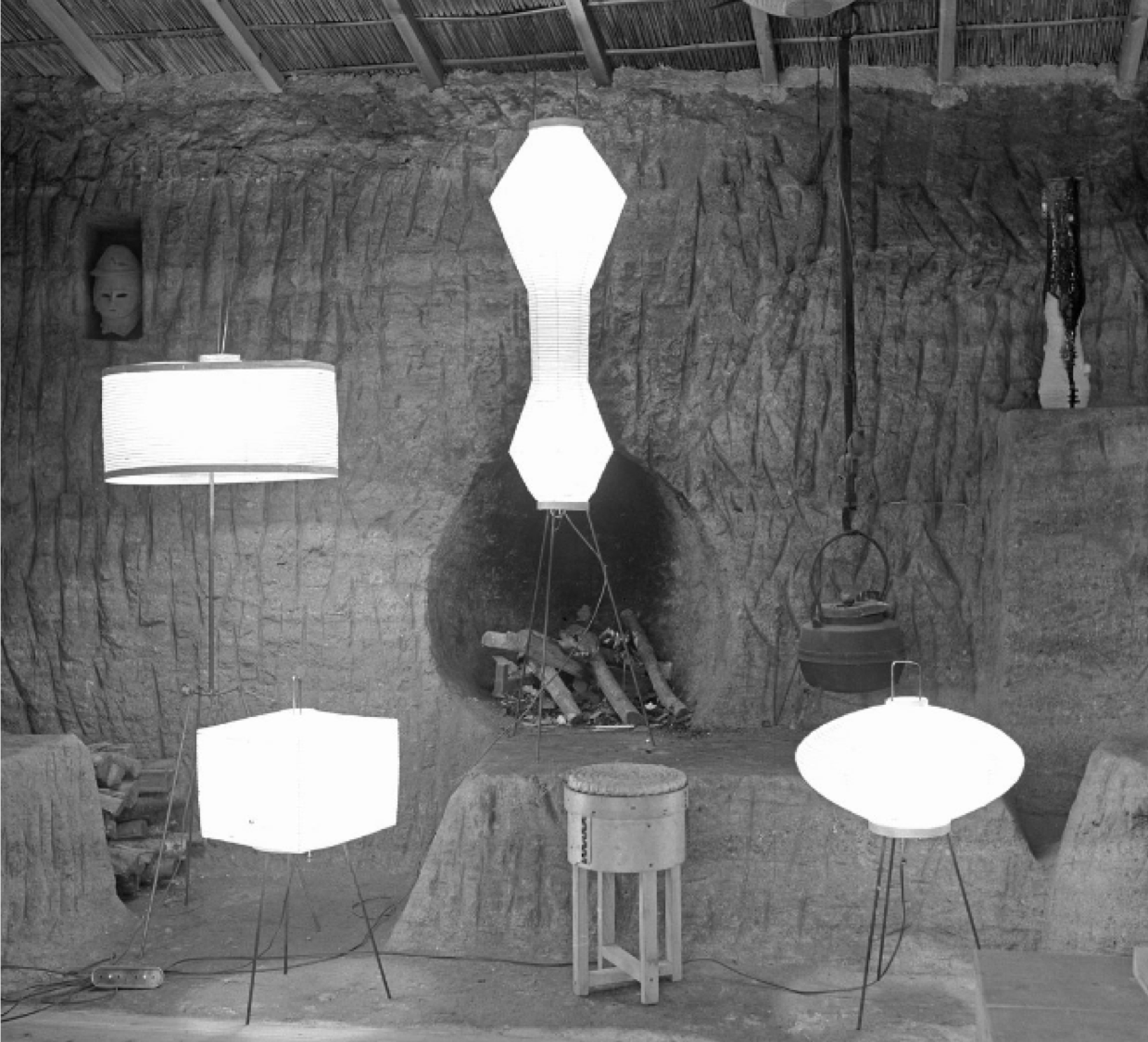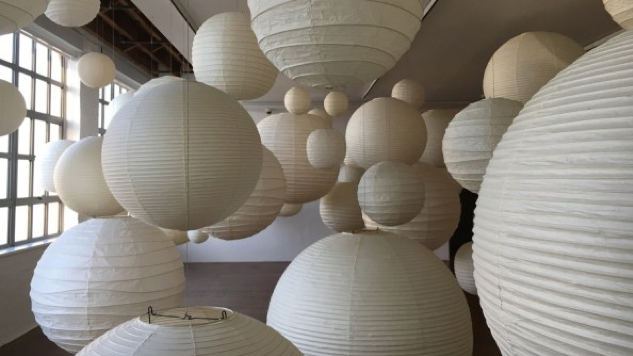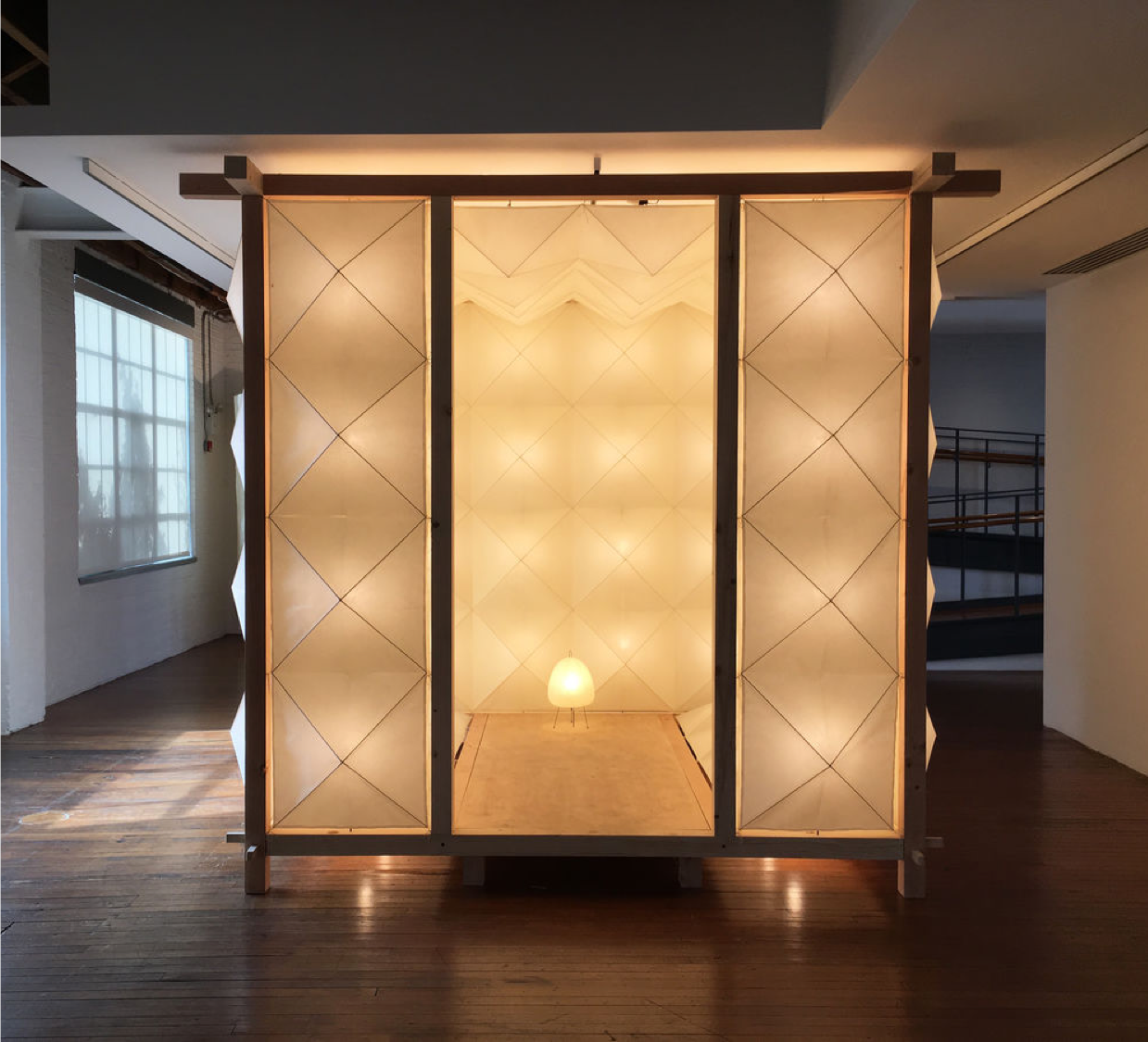Outline
Isamu Noguchi (1904–1988)was one of the twentieth century’s most important and critically acclaimed sculptors. He spent over six decades creating abstract works based on both organic and geometric forms. Akari, the result of decades of working with light had developed into Noguchi’s most successful expansion of the concepts, purposes, and potential of sculpture. His Japanese-American heritage and exploration of this dual identity infused his designs with a unique understanding of both western and eastern traditions, especially Japanese aesthetics.
I. Introduction
II. Japanese aesthetics in Akari
A. Traditional aesthetics in external features
B. Landscaping concept in spatial features
C. Zen ideology in culture dimension
III. Conclusion
Japanese Aesthetics in Isamu Noguchi’s Akari
Isamu Noguchi (1904-1988), a Japanese-American, is one of the most famous sculptors in the 20th century. This legendary artist, with more than 60 years of creative career, has left behind a large number of precious works of art for future generations, which involve a wide range of fields such as sculpture, architecture, stage scenery, furniture design and so on. He created and enhanced public spaces through sculpture, provided his career with a distinct direction and established him as a critical figure in the worlds of post-war art, architecture and design. Greatly inspired by traditional Japanese art, as well as by the biomorphic style of some Surrealist art, Noguchi presents his artistic creation to world with extremely creative methods of expression.
Akari(the word for “light as illumination” in Japanese), the representative work of Noguchi, is a series of paper lantern lamp which has been produced for more than 60years. During this period, lamps of different styles and uses entered lives of people all over the world. They are deeply loved by every household, and it is known as the oldest, best-selling and most classic Japanese style paper lamps (Schwab). As delicate paper lantern that transformed both centuries-old and contemporary notions of the lamp, Akari is the combination of tradition and modernity, also combination of east and west. Its most important modern innovation is embodied in its revolutionary modular form, which combines small pieces to build up a larger structural system. In the meantime, in several ways, Akari reflects Japanese aesthetics: it displays the characteristics of Japanese traditional aesthetics in its external features, reflects the artistic concept of Japanese landscape architecture in its spatial features, and conveys the spirit of Japanese Zen ideology in its cultural dimension.
“I sometimes think that my particular advantage, whatever it is, has been this factor of disturbance and conflict,” as Noguchi said, “that I live between two worlds and that I am constantly having conflicts of East and West, past and present.” (Libby13). Akari represented a whole new technology with clever engineering, butNoguchi’s Japanese heritage remained a powerful influence on Akari’s design.
A. Traditional aesthetics in external features
Noguchi originally conceived Akari in order to help revitalize the paper lantern industry in Gifu, Japan in 1951. The mayor of the town asked him to reawake the centuries-old art from: hand crafted paper lanterns. Noguchi accepted this challenge, electrified and contemporized the old art form ephemeral lanterns by electrically lit lamps. Each Akari consists of bamboo skeleton and dressed in airy washi paper made from mulberry tree, which disguises a bulb while softening its harsh glow (Schwab). Aside from having interchangeable parts, each Akari is lightweight and collapsible, and therefore easy to ship, store, and install. Likewise, as Kim described, “Akari light series, sculptural floor and table lamps that used fragile handmade washi paper to temper the harsh starkness of electric illumination” (30).

Figure 1 Early Akari models in Isamu Noguchi’s home studio in Kita Kamakura,Japan, c.1952. Courtesy of The Noguchi Museum.
Meanwhile, according to Plumb, Noguchi resisted all attempts to waterproof the lamps, because he felt a plastic coating would destroy the ephemeral quality of the paper, which suggests to him air and light (38). Therefore, Akari retained a distinct sensibility in its use of these traditional natural materials, which stems from the design of Japanese house. Noguchi tried to duplicate the quality of Japanese house with light filtering softly through shoji screens.
Noguchi successfully innovated the old Japanese lantern craft, naturally integrated modernization with traditional technics. This cultural amalgamation is largely due to his accumulation of artistic precipitation around the world. According to Goldberg,“Noguchi derived his concept of design as ‘high’ art from Japan, where he lived during his young and again in 1931” (8), Japanese aesthetics had informedNoguchi’s work as a sculpture from the beginning. And his apprenticeship inParis (1927-1928) in turn helped him to translate traditional Japanese aesthetics into a modern idiom. “In rural Indiana, Noguchi claimed he “got the feeling of America superimposed on the old Japanese”—assimilating the craftsmanship he had learned in Japan with new industrial techniques” (Goldberg8).

Figure 2 Isamu Noguchi, Akari model 5A (designed 1952) with its box and elements.Courtesy of The Noguchi Museum.
In my opinion, Akari not only reflects Japanese tradition in its making crafts and natural material, but also in its artistic features of minimalism, simplicity and tranquility. As Kim claimed, “For as minimally simple as these objects appear to us now, Noguchi reshaped our environs to stunning sculptural effect” (30). These features stem from the traditional Japanese aesthetic characteristics. According to Jiang, geographically speaking, Japan was in a relatively independent environment for a long time. Before modern times, there were few foreign invasion, so it developed in a relatively single environment(71). Therefore, aesthetic psychology of Japanese was also characterized by integrity, awareness, fuzziness, refinement and intuition, which was a kind of aesthetic culture full of "poetry". This kind of exquisite and obscure aesthetic feature shows a pantheistic religious worship, thus it has a simple sense of cordiality to the beauty of nature, which was the concept of "sincerity" as argued by the scholars of the Edo period. The concept of “sincerity” is artistically expressed in a non-decorative, non-artificial lyric expression, reflecting a natural and free style, which is the unique experience that Akari brings to the viewer.
B. Landscaping concept in spatial features
Noguchi intended for Akari to have a modular system, consumers can match various shades with different types of bases and move them freely, they also could suspend or mount Akari on the wall. As Voon described, “Noguchi made shades in various forms—globular, asymmetrical, geometric—and designed them to interact with lamp bases in differing ways…While some dangle from the ceiling, others balance on slim bamboo posts or sit on spindly legs, resembling small critters”. In my opinion, Akari not only enhances interior spaces, but also sculpted those spaces themselves, creating an understated interplay between light and environment. It reflects Noguchi’s unique spatial ideas. Ashe famously declared, “Space as sculpture” (noguchi.org). The hanging formation highlights Noguchi’s idea that sculpture is a dynamic way of creating space. “If you’re still, they never stop moving,” said Dakin Hart, senior curator of the Noguchi Museum. “That’s the heart and soul ofNoguchi’s idea of sculpture.” (Schwab).

Figure3 Akari: Sculpture by Other Means, 2018. Courtesy of The NoguchiMuseum.
As far as I am concerned, Noguchi mastered the relationship of space and sculpture, achieving a creative congruence between the two. His excellent mastery of space was applied to many of his famous gardens works. Noguchi’s unique design charm is the combination of sculpture and landscape design, giving the sculpture the vitality of the earth, giving the landscape a sculptural visual shock. Japanese garden art is precisely the art form that has a decisive impact on him.
In Japan, he came into contact with the traditional gardens and took great interest in their unique spatial expression and artistic realm.Along with the economic and humanistic development, Japanese gardens influenced by Zen ideology developed into the realm of “wabi-sabi” (a world view centered on the acceptance of transience and imperfection), and formed the style of “Dry mountain water” (Jiang 56). Noguchi had a deep understanding of this ideology.Since then, his "sculpture in space" has extended to "landscape in space", and began to use his unadorned and diligent creative techniques to integrate the long-lasting, charming oriental aesthetics with the western constructivist landscape design concepts, thus forming his unique design style.He always maintained a tranquil mentality when creating works, especially in the application of dry mountains, rivers and stone scenery, which became important parts of his classic works handed down from generation to generation.
C. Zen ideology in culture dimension
The beauty of Akari just stems from its simplicity. “He wanted to make things that would be timely in many different moments and places,” Dakin Hart says. “You put Akari lights in a house in any kind of architectural style, and they work. It’s because of their simplicity. Noguchi was brilliant at abstracting things to just the rightdegree. They have influences, but they never directly lock into one or the other.” (The Art Story, n.d.). This shows that the abstract and aesthetic form of Akari is constructed on the philosophy of non-specific culture. It is the crystallization and sublimation of Eastern and Western cultures, which is also the reason why it is welcomed and appreciated by the whole world.

Simplicity is an essential concept which Zen ideology emphasize.During the process of constant practice of Akari, Noguchi absorbed JapaneseZen aesthetics and deposited it as his own aesthetic foundation. He had a profound understanding of the artistic conception of "pure, empty, nihility and silence", and pursued the illusory and religious beauty, which were integrated into his all kinds of works. In the design of Akari, Noguchi regarded simple geometric shapes such as circle, ellipse, triangle and square as basic elements to be combined and reconstructed. As for material, he reserved the traditional natural washi paper, which presents clean and serene titanium white in color. The work was born in his hands, grew in the movement of time, and exists for a long time. What he gained was a quiet state of concentration and undisturbed mind.
The experience of Akari is subtle, from whimsical table-top lamps to protuberant sconces, they emanate warm light that casts gentle and relaxing spells over the surroundings. “They are testaments to imperfection. They’re about humanizing the world,” said Dakin Hart, senior curator of the Noguchi Museum. “Noguchi saw them as a counterweight to an increasingly mechanized and industrialized society. That’s why it feels like home.” (Voon). Beyond their artistic impact, Akari have an ineffable warmth to them that makes them perfect for the home. As Noguchi famously said, “All that you require to start a home are a room, a tatami (a mat), and Akari” (Schwab).
Today, the electric paper lamp is a common lighting fixture, but Noguchi’s designs were unorthodox at the time. It has become an iconic part of mid-century modern design, which is still going strong to this day. “These things are life-changers,” Hart said. “They shape our environments, but they also shape how we feel. Each is capable of creating that magic of what we think of as home.” (Voon). That power, it seems, is one element that cannot quite be replicated. At the same time, Noguchi's innovative design philosophy, which transcends the traditional way of drawing on cultural elements restrictedly, also brings deeper enlightenment to posterity.
Works Cited
Goldberg, Deborah Ann. Isamu Noguchi: Theartist as engineer and visionary designer. Ph.D. New York University. 2000.
Jiang, Wenqing. Eastern Classical Beauty: A Comparison of Chinese and JapaneseTraditional Aesthetic Consciousness. China Social Science Press. 1September 2002.
Kim, Carpenter. “Organic Utilitarianism theSculptures of Isamu Noguchi”. Sculpture Review, 57 no.1, Spring 2008.
Libby, Brain. “Isamu Noguchi: The Artist andFurniture Designer Blended Eastern and Western Influence”. Treasures, December2017/ January 2018, p.13.
Noguchi.org. (2018). Noguchi Talks | Beginnings | The Noguchi Museum.https://www.noguchi.org/programs/public/noguchi-talks-beginnings. Accessed 27Nov. 2018.
Plumb, Barbara. “New Designs Shown inJapanese Paper Lanterns”. New York Times (1923-Current file). 31 March 1964,p.38.
Schwab, Katharine. “The Secret History of the Paper Lantern Lamp.” FastCompany, 2 March 2018, https://www.fastcompany.com/90162330/the-secret-history-of-the-paper-lantern-lamp.Accessed 24 November 2018.
The Art Story. (n.d.). Isamu Noguchi Overview and Analysis.https://www.theartstory.org/artist-noguchi-isamu.htm. Accessed 25 November2018.
Torres, Ana Maria and Sadao, Shoji. Isamu Noguchi: A Study of Space. New York:The Monacelli Press. 2000.
Voon, Claire. “How Noguchi Sculptures Inspiredthe Paper Lamps We See Everywhere.” 11 Artworks, Bio & Shows on Artsy,Artsy, 28 May 2018,www.artsy.net/article/artsy-editorial-noguchi-sculptures-inspired-paper-lamps. Accessed24 November 2018.




